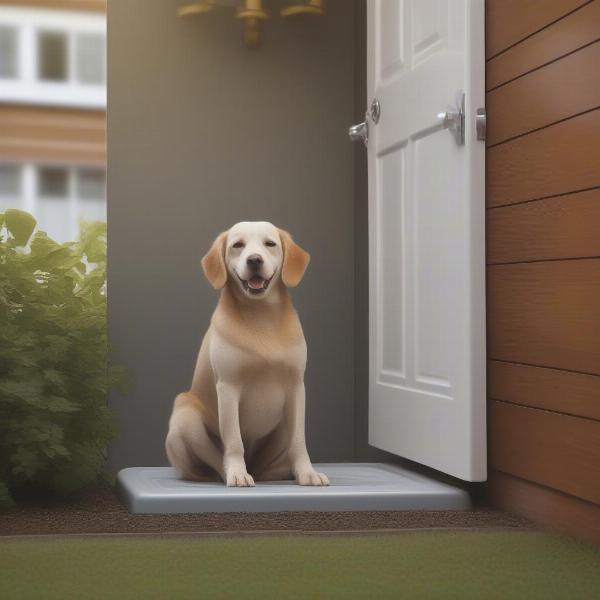Having an outside dog toilet can be a convenient solution for many pet owners. Whether you have a small yard, live in an apartment, or simply want to make potty breaks easier, understanding the options, benefits, and potential drawbacks of an outside dog toilet is essential. This guide will explore everything you need to know about setting up and maintaining an outside dog toilet for your furry friend.
Choosing the Right Outside Dog Toilet
There are various types of outside dog toilets available, each with its own pros and cons. Consider your dog’s size, breed, and preferences when making your selection.
- Grass Patches: Real grass offers a natural feel and can be a good option for dogs who prefer the feel of grass under their paws. These often require regular maintenance, including watering, fertilizing, and cleaning.
- Potty Pads on a Designated Area: This involves training your dog to use potty pads placed on a specific area outside, such as a balcony or patio. It’s relatively low-maintenance but requires consistent training.
- Artificial Turf Systems: These systems typically involve a layer of artificial grass over a drainage system. They can be more hygienic than real grass and require less maintenance, but some dogs may not take to the artificial texture.
- Dog Litter Boxes: Designed for outdoor use, these boxes are filled with special absorbent materials like wood chips, mulch, or pellets. They can be easily cleaned and are suitable for small spaces.
Training Your Dog to Use an Outside Dog Toilet
 Dog Successfully Using an Outside Toilet
Dog Successfully Using an Outside Toilet
Successfully training your dog to use their outside toilet requires patience and consistency. Start by introducing your dog to the designated area and rewarding them with praise and treats whenever they eliminate in the correct spot. Establish a regular potty break schedule and stick to it, especially during the initial training phase. Be prepared for accidents and avoid punishment, as this can create negative associations with the toilet area. dog toilet training regression offers more detailed information on toilet training.
Troubleshooting Common Issues
Some dogs may be resistant to using an outside toilet at first. Here are a few common issues and how to address them:
- Dog avoids the toilet area: Ensure the area is clean and free of any unpleasant odors. Try using a different type of toilet if your dog doesn’t seem to like the current one.
- Dog eliminates near, but not on, the toilet: Re-introduce your dog to the designated spot and reinforce the desired behavior with rewards.
- Dog continues to have accidents inside: Review your training methods and ensure you’re providing enough potty breaks.
Maintaining Your Outside Dog Toilet
Regular cleaning is crucial for maintaining hygiene and preventing odors. The cleaning frequency will depend on the type of toilet you choose. Grass patches require regular scooping and occasional cleaning with pet-safe disinfectants. Potty pads should be changed frequently. Artificial turf systems need to be rinsed regularly and disinfected periodically. yard full of dog shit might be helpful if you are facing challenges with a messy yard.
Conclusion
An outside dog toilet can be a convenient and practical solution for many pet owners. By choosing the right type of toilet, implementing consistent training, and maintaining proper hygiene, you can create a comfortable and sanitary potty area for your furry friend. Remember to consider your dog’s individual needs and preferences when making your decision. dog toilet provides further insights on different toilet solutions for dogs.
FAQ
- How do I choose the right size outside dog toilet? Consider your dog’s size and ensure they have enough space to comfortably turn around and eliminate.
- Can I use an outside dog toilet for a puppy? Yes, but you’ll need to start with a smaller toilet area and gradually increase the size as your puppy grows.
- What should I do if my dog refuses to use the outside dog toilet? Review your training methods, try a different type of toilet, or consult with a professional dog trainer.
- How often should I clean the outside dog toilet? This depends on the type of toilet, but regular cleaning is essential for maintaining hygiene.
- Are there any health concerns associated with outside dog toilets? Ensure the toilet area is kept clean to prevent the spread of bacteria and parasites.
- Can I use an outside dog toilet in an apartment? Yes, certain types of outside dog toilets, like potty pads or dog litter boxes, are suitable for apartment living.
- What are the benefits of using an outside dog toilet? It can provide convenience for pet owners, reduce the need for frequent walks, and maintain a cleaner yard.
Related Articles You Might Find Helpful:
mobile dog grooming wigan
dog crate cover nz
About ILM Dog
ILM Dog is your trusted international resource for all things dog-related. We offer expert advice and practical tips on a variety of topics, including dog breeds, health and medical care, training, nutrition, grooming, exercise, puppy care, senior dog care, and travel. We aim to empower dog owners with the knowledge and resources they need to provide the best possible care for their canine companions. For expert guidance on dog products and accessories, or if you have any questions, feel free to contact us via email at [email protected] or phone at +44 20-3965-8624. Visit ILM Dog for more information.